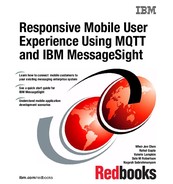

Scenarios overview
This chapter provides an overview of the scenarios that are implemented in later chapters of this book. The company profile, business problems, and the application requirements are described in 5.7, “MQTT hybrid application use case and requirements” on page 130. These scenarios provide a solution to the business problems of the fictional company, and demonstrate how a mobile application can be integrated with the back-end system to achieve the required solution.
This chapter includes the following sections:
•Scenario 4 overview
All of these scenarios assume trusted devices connecting from trusted networks. They do not explicitly cover public internet or bring your own device (BYOD) scenarios.
6.1 Scenario 1 overview
Scenario 1 uses the MQTT hybrid mobile application developed for the Android platform. This scenario describes how authentication and authorization can be achieved from IBM MessageSight.
Truck drivers log in to the mobile application before starting for a delivery, and log out when back to the station after completing the delivery. Truck drivers submit their user name, password, and truck number for authentication and authorization. These credentials are used by the mobile application to establish secure connectivity with IBM MessageSight. The truck number is used as a
client identifier.
client identifier.
This Mobile application establishes secure connectivity with the IBM MessageSight server. To establish this connectivity, the mobile application provides driver credentials (user name, password, and truck number) for authentication and authorization.
Figure 6-1 provides an overview of this scenario. For more details about this scenario, see Chapter 7, “Scenario 1: Secure messaging” on page 183.

Figure 6-1 Authentication and authorization for the MQTT mobile application
6.2 Scenario 2 overview
Scenario 2 uses the MQTT hybrid mobile application developed for the Android platform for drivers to send roadside assistance requests and responses through IBM MessageSight. The roadside assistance requests are sent with the type of request needed, and the accurate geographic location of truck.
The back-end application hosted on IBM Integration Bus performs the following functions:
The back-end application hosted on IBM Integration Bus performs the following functions:
•Receives these messages on WebSphere MQ Java Message Service (JMS)
•Maps the WebSphere MQ topics from the IBM MessageSight server to the WebSphere MQ queue manager
•Processes the assistance request and sends a corresponding response to the requester
Assistance requests and responses are sent with a highest quality of message delivery QoS2.
Figure 6-2 provides an overview of this scenario. For more details about this scenario, see Chapter 8, “Scenario 2: Request and response using MQTT” on page 201.

Figure 6-2 Roadside assistance requests for the MQTT mobile application
6.3 Scenario 3 overview
Scenario 3 uses the MQTT hybrid mobile application developed for the Android platform for truck drivers to be alerted with critical and important notifications. This scenario is divided into two sub-scenarios:
•Push notification for selected trucks based on their geographic location
•Push notification for all trucks in the fleet
6.3.1 Push notification for selected trucks based on their location
To help drivers save time and be safe on highways, the ITSO Transport company wants to develop a push notification system that analyzes trucks’ current geographic location and notifies truck drivers of any problems predicted on their route to delivery. Any changes in the geographic location of the trucks are captured, based on the area that the trucks are currently in, and any critical notifications are sent to specific trucks in that area.
An example of such a notification is, “Bay bridge is closed, plan alternative route”.
Figure 6-3 shows an example of push notification to selected trucks.

Figure 6-3 Push notification for selected trucks
6.3.2 Push notification for all trucks in the fleet
The ITSO Transport Corporation back-end office team and supervisors might sometime want to alert all of the trucks currently delivering groceries with a few important notifications.
IBM MessageSight receives publications from back-end enterprise applications or mobile applications, on specific topics, to send broadcast messages to all trucks currently delivering groceries. The broadcast message is later published to the mobile application in trucks that have subscribed on matching topic strings.
An example of this broadcast push notification is, “Drive safely and obey state traffic laws”.
Figure 6-4 provides an overview of a broadcast push notification.

Figure 6-4 Push notification broadcast to all trucks
For more details about this scenario, see Chapter 9, “Scenario 3: Push notifications with quality of service” on page 225.
6.4 Scenario 4 overview
Scenario 4 uses the MQTT hybrid mobile application developed for the Android platform for drivers to send roadside assistance requests and responses through IBM MessageSight. The roadside assistance requests are sent with the type of request needed, and with the accurate geographic location of truck.
In this scenario, the back-end applications are coded as stand-alone Java implementations for MQTT and JMS, which communicate with IBM MessageSight directly. These applications process the assistance requests, and send corresponding responses to the requester. Assistance requests and responses are sent with a highest quality of message delivery QoS2.
Figure 6-5 provides an overview of this scenario.

Figure 6-5 Roadside assistance and request for MQTT mobile application using stand-alone back-end system
For more details about this scenario, see Chapter 10, “Scenario 4: Stand-alone server applications” on page 281.
..................Content has been hidden....................
You can't read the all page of ebook, please click here login for view all page.
